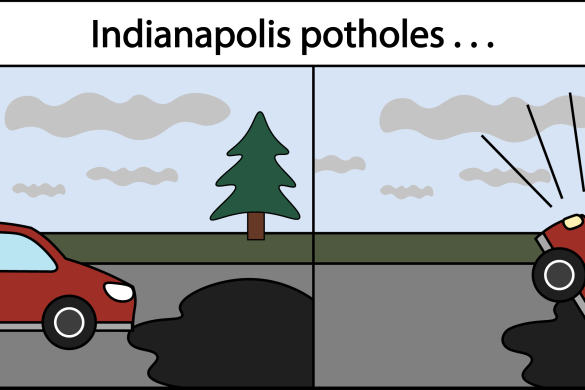Pro: Indiana Statewide Testing for Educational Progress and other standardized tests are often criticized by students and teachers alike. Many believe that the pressure of the tests take away from actual learning and that they limit the teachers’ abilities to effectively educate their students.
Although the standardized testing process is not perfect and is due for some improvement, it is necessary on some level. Public education is paid for with taxpayer money, so there is an inherent standard that must be met in the quality of education. Saying that no standard should exist for teachers to meet would be like saying that roads need not be inspected after they are built. While educators should be able to implement some personalized and specialized forms of education in their curriculum, they also need to meet a minimum requirement.
Although ISTEP+ tests are being removed in Indiana in the near future, they ultimately will be replaced by the ILEARN test in 2019, according to the Indiana Department of Education. ILEARN will follow many of the same processes that ISTEP+ did, meaning that students in grades three to eight will be required to test their English and language arts knowledge and students will have to pass end-of-course assessments (ECA) to pass high school.
Standardized testing allows educators and administrators to track the growth or regression of students throughout their schooling. Ideally, this would lead to teachers responding to the needs of each individual student to help him or her improve in areas where he or she may be struggling. Although no one likes to admit it, we all have biases, even teachers. Standardized tests eliminate educator bias, leaving it up to pure test scores. Ideally, standardized tests are supposed to create well-rounded students who can perform in a variety of subjects. These tests allow researchers to collect data on the patterns of growth in education at state and national levels.
One of the most resonant arguments against standardized testing is that it determines the amount of funding each school receives. Those who oppose
standardized tests argue that this perpetuates lower overall test scores at schools that receive less funding, creating an inescapable cycle. I actually agree with this point and believe it is at the root of all the other issues that arise with standardized tests. School administrators know that test scores will affect funding, so they put pressure on teachers to increase test scores. Teachers then put pressure on students to increase their individual scores which, again,
creates a cycle. Standardized testing should be reformed as a way to collect data for research rather than a way to determine funding for schools. By
doing this it would allow education funding to be distributed evenly and possibly improve the scores of schools that historically score lower.
I will be the first to admit that standardized testing was one of my least favorite aspects of school, but I understand the necessity of it on some level. Although there is significant room for reform and improvement, saying that the ISTEP+ and similar tests do not have significant value in terms of setting a standard for education would be foolish. I fully agree that education needs to have some personalization to focus on the needs of each individual, but there also needs to be some general knowledge of all subjects so that students are well-rounded. Hopefully, policy makers in Indiana will learn from the flaws and mistakes of ISTEP+ and improve with ILEARN which will begin in schools starting in the 2018-2019 school year.
–Erik Cliburn
Con: From grades three to eight and then again in tenth grade, Indiana students find themselves taking a number of Indiana Statewide Testing for Educational Progress-Plus tests. Currently, students are testing in multiple rounds during the spring semester. Part one consists of “applied skills (open-ended items),” while part two is made up of multiple-choice questions, according to the Indiana Department of Education website. Grade level determines the number of tests students take in each half. According to the IDOE website, each grade level is tested in English/language arts and mathematics across multiple tests. In grades four, six and ten, students also are tested in science. In grades five and seven, they are tested in social studies. This adds another three to four tests to the already lengthy exam.
The purpose of ISTEP+ is to measure student achievement and mastery of Indiana’s standards, but in many ways, it detracts from student success and learning. Standardized tests do not inspire a love of learning or encourage students to explore, discover and make connections within the classroom and the world. Instead, students find themselves spending class time learning the skills needed to pass a test, not working to understand or engage material. Students might become proficient test-takers, but they are not learning content or some of the skills the different subjects teach, such as critical thinking, analysis or problem-solving.
In addition, the pressure student performance on the ISTEP+ puts on teachers and schools hinders student learning. According to indianapublicmedia.org, in some corporations, ISTEP+ scores determine a teacher’s salary or eligibility for a raise. They also play a role in a school’s yearly letter grade from the IDOE. With pressure on educators to ensure that their students pass and earn high marks on the ISTEP+, many sacrifice creativity in the classroom.
ISTEP+ itself is not an effective measurement of student achievement, despite the weight it is given in evaluating educators, schools and students. It does not take into account external factors that could affect the student, such as home life or test anxiety. Additionally, it does not take into account student growth from year-to-year or test-to-test. ISTEP+ is a criterion-referenced evaluation, meaning it measures student achievement based on the student’s ability to meet a defined standard. However, it is being used as a norm-referenced evaluation, which is when a student’s score is measured against the scores of other students, instead of a set standard. This skews the validity of a student’s score and its usage to measure teacher or school success.
As a future educator, I have seen first hand the emphasis being put on ISTEP+. In the various classrooms I’ve observed, teachers work with their students on comprehension questions and how to best break apart a selection of text to find answers. I have heard teachers say, “If you don’t master this, you’re going to struggle on ISTEP+,” or use examples of student work to point out “This isn’t going to work on ISTEP+.” I have seen bored students reading uninteresting articles and completing worksheets, their curiosity and potential engagement with the text stifled. I have heard teachers grumble about having their class time taken away so that students can sit in front of a computer screen and take a standardized test. I have heard students complain about school being boring, ISTEP+ being challenging and having to spend so much of their last few weeks of school taking a test. School is a place that is supposed to spark students’ interests and desire to learn and teach them skills that go beyond the classroom, not teach them how to take a test and regurgitate information. This is mostly what students are getting when standardized test scores are given so much weight, and it is far less than the students need or deserve.
I hope that student and teacher experiences and the studies that have been done on standardized testing and student achievement lead to DOEs across the country recognizing the problems that occur when standardized tests are given too much weight. With the ISTEP+ replacement tests, ILEARN, potentially rolling out in 2018-19, it seems we have a way to go. Student learning, curiosity and engagement should be the focus of educators and schools, not a test score.
–Maia Gibson









